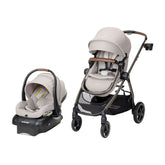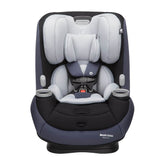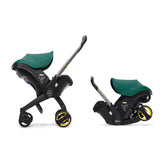Pumping Breast Milk: When to Start and How to Do It Successfully

Updated 20 Dec 2024
Pumping is a simple and effective way to provide your baby with breast milk when you’re not around. It’s also a handy tool for moms who may be uncomfortable with feeding directly from the breast or babies who are unable to latch. In addition, pumping can help with a variety of other issues nursing issues, such as relieving engorgement, increasing your milk supply, and healing mastitis. While the various tubes and machinery components may look a bit overwhelming at first, pumping breast milk is a fairly straightforward process once you get the hang of it. Here’s what you need to know to get started.
When Should I Start the Pumping Process?
If your newborn is healthy and gaining weight and there’s no expected need for separation (e.g., mom has to return to work), experts recommend delaying the use of a pump until your infant is about six weeks old. In the early days and weeks after birth, there is often very little time between breastfeeding sessions to pump. Lactation experts also suggest delaying introduction of the bottle for a few weeks until breastfeeding is well established. Instead, use a hand pump to express any excess milk.
Other women, however, begin pumping immediately following birth. These are often doctor-advised situations in which an infant has low blood sugar at birth, a low birth weight, or jaundice. In other cases, mothers may be separated from their infants for medical reasons and choose to pump and store milk in order to begin establishing their milk supply. Women who plan to return to work frequently begin pumping about a month before their return date to familiarize themselves with the process and begin stocking up on expressed milk. Pumping while still pregnant is not recommended as this can trigger early labor.
Medela Swing Breast Pump is an occasional use breast pump for lactating women to express and collect milk from their breasts to complement breastfeeding and is a single-user product. Perfect for quick, efficient expression whenever you need it. Ideal for breastfeeding parents who want to share feeding with a partner, get out for an appointment, or simply take a break.

What Time of Day Should I Pump Breast Milk?
The ideal time of day to pump is different for every woman (and may be different depending on the day). In general, though, first thing in the morning is the time when many women express the most milk. This is due to the fact that your body creates prolactin (a hormone that triggers milk production) during the night.
To begin stocking up on expressed milk, nurse your baby after getting up in the morning, then pump both breasts at the same time for approximately 10 to 15 minutes. Double pumping saves the most time and stimulates increased prolactin production, key to maintaining a good milk supply.
Some parents also pump after each nursing session. If you choose to do this, keep in mind you are pumping “leftovers” and should only anticipate a small amount of milk. Other parents pump during the time between regular feeding sessions. Both methods help boost milk production.
Medela brings the iconic Medela Swing Maxi Double Electric Breast Pump into the modern age with a contemporary and stylish redesigned Swing Maxi. Improve your mobility thanks to the built-in rechargeable battery that lasts for up to 6 pumping sessions. And continue to benefit from Medela’s Flex™ technology that offers you flexibility and the comfortable, efficient pumping experience you deserve.

Medela Swing Maxi Double Electric Breast Pump
How Frequently and How Long Should I Pump?
After a breastfeeding session, 10 to 15 minutes with an electric breast pump that works both breasts simultaneously should be sufficient. If you’re pumping instead of nursing your infant, it may take closer to 20 minutes or even up to 30 minutes to fully drain the breasts.
In general, you’ll need to pump as often as the baby would be nursing, approximately every two to four hours until the milk slows down and your breasts begin to feel empty (about 15 minutes). Pumping on the same schedule as your baby's feedings back at home helps keep your milk supply going strong and aligned with your baby’s demand. For example, if you’ll be away from your baby for eight hours of work, your nursing/pumping schedule may look something like this:
- Nurse before heading to work.
- Pump mid-morning.
- Pump at lunch or two to three hours later.
- Pump again mid-afternoon or before heading home, if necessary.
- Nurse baby when you return home.
If you’re currently nursing full-time and are trying to pump to build up a freezer stash or to stock up for an upcoming brief separation, expressing extra milk may be challenging as your infant may be draining most of your supply. You may need to pump multiple times to get enough milk for one feeding—and that’s normal. It’s also normal to have an abundance of breastmilk in the early weeks or months after delivery as your body adjusts to your baby’s needs. Once your newborn settles into a routine and your supply begins to self-regulate, you may see a bit of a decrease relative to the oversupply you once had.
The Medela Breast Milk Cooler Set is great as an extra set for bringing to work or school to store pumped breast milk or for leaving at daycare with your baby. The contoured cooling element is designed specifically for your Medela breast milk bottles.

What Is Power Pumping, and How Do I Do It?
If you need to boost your milk supply you can try power pumping. Power pumping simulates cluster feeding. This is when your infant nurses very frequently, which then triggers your body to start producing more milk. In other words, power pumping is a way of “jumpstarting” your milk supply to allow you to build a stockpile of milk for your infant.
While power pumping can take the place of a single regular pumping session, it does not replace regular pumping or nursing. Instead, it's meant to be done as a supplement to your normal routine. This technique works better for babies who are bottle-fed some or all of the time. If you’re exclusively breastfeeding, you may find it challenging to produce the extra milk between feeding sessions.
To power pump, choose a relaxed, quiet time for uninterrupted pumping. Pump for 10 minutes, and then rest for 10 minutes. Continue the cycle for a full hour (a total of three pumping sessions in a 60-minute span). Some moms power pump in two separate sessions due to time constraints (30 minutes of power pumping, twice daily).
It will take a few days for your milk supply to respond to this increase in demand. Some lactating parents observe an increase in as little as three days, while others may power pump for a full week before seeing results.
Store, transport, and warm breast milk in these convenient, ready-to-use Medela Breast Milk Storage Bags. Constructed from a durable, double layer material and built-in double zipper seal to keep your breast milk safely stored in the fridge or freezer. For added convenience, the bags are self-standing and come with a large write-on area so you can track the date and other important information. A BONUS resealable transport pouch is included to help keep the bags clean and organized.

Medela Breast Milk Storage Bags
How Can I Make Sure I Have Enough Milk for Pumping?
Breastfeeding works on a supply and demand basis – the more demand there is (from your baby or your pump), the more supply (breast milk) you’ll produce. Here are a few tips that can help you maintain your milk supply and maximize efficiency while pumping:
- Stay hydrated and well-fed. Nursing burns a tremendous amount of calories. The CDC recommends that breastfeeding women eat a healthy, balanced diet that allows them to consume an additional 450 to 500 calories per day. Keep water nearby to sip throughout your pumping session.
- Massage your breasts and/or use a warm compress on your breasts before a pumping session to stimulate the letdown reflex.
- Relax. A happy relaxed mom produces oxytocin, the hormone that triggers milk release (letdown). Listen to a guided relaxation or soothing music or look at photos of your baby to boost letdown even more.
- Fully drain your breasts during each nursing or pumping session.
- Invest in a hands-free bra. This allows the flanges to be held up by the bra so mom doesn’t have to, allowing her up to do something else with her hands while she’s pumping.
The Medela Maternity and Nursing Comfort Bra is accessible and easy to wear. “Open-and-close” clips and full drop cups are easy to unhook and reattach during breastfeeding, with extra assurance to remain in place when needed.

Medela Maternity and Nursing Comfort Bra
The Takeaway on Pumping Breast Milk Successfully
Building your confidence and learning about effective pumping strategies are essential for pumping success. Whether you’re trying to build a stockpile for occasional use or pumping exclusively, practicing these pumping techniques and educating yourself about what to expect will help you get the most out of each session. If you’re having difficulty getting started, consider contacting an IBCLC (International Board of Lactation Consultant Examiners) certified lactation consultant here. With time and patience, you’ll have a breast milk stockpile that will allow you to continue your breastfeeding experience.









